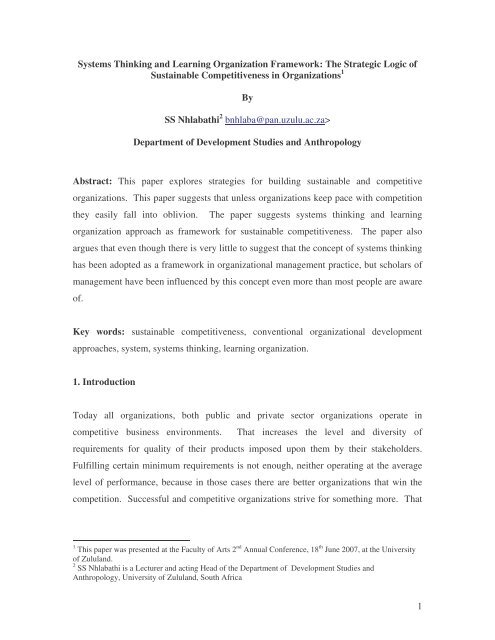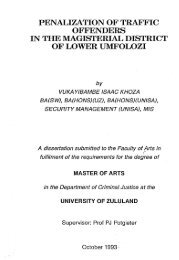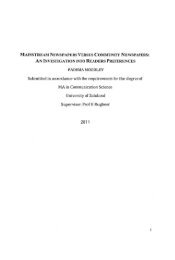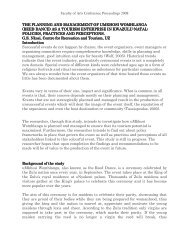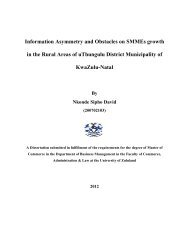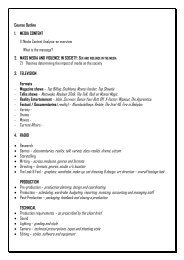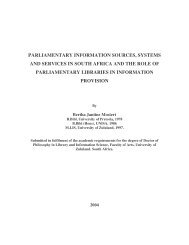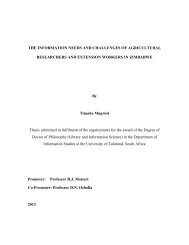1 Systems Thinking and Learning Organization Framework: The ...
1 Systems Thinking and Learning Organization Framework: The ...
1 Systems Thinking and Learning Organization Framework: The ...
You also want an ePaper? Increase the reach of your titles
YUMPU automatically turns print PDFs into web optimized ePapers that Google loves.
<strong>Systems</strong> <strong>Thinking</strong> <strong>and</strong> <strong>Learning</strong> <strong>Organization</strong> <strong>Framework</strong>: <strong>The</strong> Strategic Logic ofSustainable Competitiveness in <strong>Organization</strong>s 1BySS Nhlabathi 2 bnhlaba@pan.uzulu.ac.za>Department of Development Studies <strong>and</strong> AnthropologyAbstract: This paper explores strategies for building sustainable <strong>and</strong> competitiveorganizations. This paper suggests that unless organizations keep pace with competitionthey easily fall into oblivion. <strong>The</strong> paper suggests systems thinking <strong>and</strong> learningorganization approach as framework for sustainable competitiveness. <strong>The</strong> paper alsoargues that even though there is very little to suggest that the concept of systems thinkinghas been adopted as a framework in organizational management practice, but scholars ofmanagement have been influenced by this concept even more than most people are awareof.Key words: sustainable competitiveness, conventional organizational developmentapproaches, system, systems thinking, learning organization.1. IntroductionToday all organizations, both public <strong>and</strong> private sector organizations operate incompetitive business environments. That increases the level <strong>and</strong> diversity ofrequirements for quality of their products imposed upon them by their stakeholders.Fulfilling certain minimum requirements is not enough, neither operating at the averagelevel of performance, because in those cases there are better organizations that win thecompetition. Successful <strong>and</strong> competitive organizations strive for something more. That1 This paper was presented at the Faculty of Arts 2 nd Annual Conference, 18 th June 2007, at the Universityof Zulul<strong>and</strong>.2 SS Nhlabathi is a Lecturer <strong>and</strong> acting Head of the Department of Development Studies <strong>and</strong>Anthropology, University of Zulul<strong>and</strong>, South Africa1
is expressed in the modern quality approaches by aiming at performance excellencewhich translates into sustained high growth in both revenues <strong>and</strong> profits.<strong>Organization</strong>s have sustainable competitiveness when they consistently produce products<strong>and</strong>/or deliver systems with attributes which correspond to the buying criteria for themajority of the customers in their targeted market. Sustainable competitiveness isenjoyed by those organizations who are appealing to current, or emergent, majority ofcustomers in their target market (Hall, 1993: 610). In order to have sustainablecompetitiveness, Coyne (1986: 57) suggests that not only do product <strong>and</strong>/or deliverysystem attributes need to be significant to customers, but to be sustainable they also needto be the result of a capability differential which will endure.In view of this, this paper explores strategies <strong>and</strong> processes for turning organizations intosustainable <strong>and</strong> competitive systems. This paper argues that organizations will attaincompetitive sustainability only by adopting <strong>Systems</strong> thinking <strong>and</strong> learning organizationapproach. <strong>The</strong> reason why <strong>Systems</strong> thinking <strong>and</strong> learning organization approach ispromoted arises from the fact that conventional approaches to organizationaldevelopment which have coloured how people look at the world have not been able toprovide long-term <strong>and</strong> longer lasting solutions to present day organizational problems.Because of this there is a need to think differently about problems that organizations face.<strong>Systems</strong> thinking approach provides a different perspective to underst<strong>and</strong>ing worldproblems. This concept helps people see patterns in the world <strong>and</strong> identify specificleverage points that can be used to produce lasting, beneficial changes within systems(Haines et al, 2005: 40-46). <strong>The</strong> paper explores this concept <strong>and</strong> argues that this conceptneeds to be used deliberately as a framework in organizational development practice.This paper also argues that even though the concept of systems thinking has not beenused widely as a framework in management practice but scholars of management havebeen influenced by this concept even more than most people are aware of.2
This paper opens by reviewing models of conventional approaches to organizationalmanagement. <strong>The</strong> paper shows that conventional approaches to management have notbrought about sustainable competitiveness in organizations <strong>and</strong> by implication can not berelied upon to turn organizations into world class systems. Since conventionalapproaches to management offer limited solutions this paper turns to systems thinking<strong>and</strong> learning organization framework, as an approach for sustainable organizationalchange. <strong>The</strong> paper further shows the influence of systems thinking approach intomanagement <strong>and</strong> leadership theory.2. Conventional Approaches to <strong>Organization</strong>al DevelopmentAs it was suggested above leaders of organizations are concerned about growing <strong>and</strong>sustaining the organizations that they lead. <strong>The</strong> question is how can sustained growth beachieved? Sustained organizational growth has proven to be elusive. Kim <strong>and</strong>Mauborgne (1997) point out that after decades of downsizing <strong>and</strong> increasingly intensecompetition, profitable growth is still a tremendous challenge in many companies.Studies (Strebel, 1996; Beer et al, 1990; Garvin, 1993; Bridges <strong>and</strong> Mitchell, 2000; <strong>and</strong>Senge et al, 1999b) also show that most organizations have not been successful both intheir turnaround strategies <strong>and</strong> in their general change efforts.Anecdotal evidence, decades of experience in the change field, smaller research studies,numerous conversations with other prominent consultants <strong>and</strong> writers suggest thatapproximately 75 percent of all major change initiatives fail to fully meet their initialobjectives (Haines, et al, 2005: 20). Holbeche (2005: 6) reports that 75 percent of alltransformation efforts fail, <strong>and</strong> re-engineering efforts fails are between 50 <strong>and</strong> 75 percent.This view is also supported by Wheatley (1997). Kotter (1995: 59) writes that a fewcorporate change efforts that have gone under many banners: total quality management,reengineering, right sizing, restructuring, cultural change, <strong>and</strong> turnaround have beensuccessful. Many have been utter failures. Kotter (1998) further elaborates on this pointthat according to most assessments fewer than fifteen of the hundred or more companieshe has studied have successfully transformed themselves.3
Studies further suggest reasons why change management strategies fail. Pascale, et al(1997: 127) attribute change programme failures to the fact that the whole burden ofchange tends to rests on a few people. <strong>The</strong>y state that the number of people at every levelwho make committed <strong>and</strong> imaginative contributions to organizational success is simplytoo small. Bridges <strong>and</strong> Mitchell (2000) suggest that change management programmesfail because they tend to neglect the dynamics of personal <strong>and</strong> organizational transitionthat can determine the outcome of any change effort. Strebel (1996:86) points out thatchange fails because managers <strong>and</strong> employees view change differently. Few leadersrecognize the ways in which individuals commit to change to bring it about. For manyemployees, including middle managers change is neither sought after nor welcomed. It isdisruptive <strong>and</strong> intrusive. It upsets the balance.Beer, et al (1990) add another dimension to lack of success in organizational changeefforts by stating that revitalization fails because the idea often comes about throughcompanywide change programmes sponsored by corporate staff. Beer et al call this “thefallacy of programmatic change”. Senge (1999) points out that most organizationalchange effort fails because they are based on a premise of a definitive formula rather thanan ongoing process. Some popular change strategies such as downsizing, re-engineering,<strong>and</strong> “slash <strong>and</strong> burn” retrenchments often fail to sustain themselves. Hartman (2004: 12)is also critical of slash-<strong>and</strong>-burn strategy pointing out that it is far too limited. He pointsout that slash-<strong>and</strong>-burn offers quick-fix solutions. On the slash-<strong>and</strong>-burn strategy,Holbeche (2005: 10) quotes Hammer (2001) who states that business re-engineeringduring the 1990s went too far, in some cases cutting into not just the “fat” of theorganization but also its bones <strong>and</strong> sinews. This resulted in what is called corporate“anorexia” which made organizations become too lean to be able to respond flexibly <strong>and</strong>innovatively in an increasingly competitive global market place.In a study done by Nhlabathi (2006) on strategies to build sustainable competitiveorganizations, it was found that organizations fail to meet their potential for the followingreasons: lack of commitment by staff to the organization <strong>and</strong> to the change process;4
inability of an organization to respond to its environment; putting one’s interest ahead ofthat of on organizations; ideological orientation of some staff which is at variance withthe vision of the organization; the tendency to blame the next person for problems in anorganization; lack of clearly defined common vision; hostilities amongst staff; <strong>and</strong>, an allpowerful management, the “hero” CEO.<strong>The</strong> above exposition <strong>and</strong> the results of the study done by Nhlabathi (2006) show that forone to bring about superior results in an organization one needs to go beyondconventional approaches of organizational development. <strong>The</strong>re is therefore a need for aparadigm shift in leadership from traditional approaches to systems thinking approach toproblem solving (Haines et al, 2005: 40-46).3. <strong>Systems</strong> <strong>Thinking</strong> <strong>Framework</strong> <strong>and</strong> Sustainable Competitiveness: Why anInterest in <strong>Systems</strong> <strong>Thinking</strong>?<strong>The</strong> Industrial Revolution came with great changes in the way production was done.Managing the new forms of production created a need for some new methods for dealingwith the management issues. One theory of management that had far reaching effect inthe field of management is scientific management developed by Frederic Winslow Taylor(1856-1915). Taylor was one of the first to attempt to systematically analyze humanbehaviour at work (Wertheim, 1999). Through the principles of scientific managementFrederick Taylor wanted to show that fundamental principles of scientific managementare applicable to all kinds of human activities. Scientific management was employed toprovide a logical, systematic <strong>and</strong> thorough analysis of shop-level problems. Effortstowards increased efficiency which would result in both increased profits <strong>and</strong> higherwages fostered the development of specific procedures within individual companies(Jackson, 2000: 199).<strong>The</strong> ideas of Frederick Taylor later to be called Taylorism led to concepts of viewingorganizations as smoothly running machines. Taylorism had profound results as it led todramatic improvement in productivity (Wertheim, 1999). New departments arose such as5
industrial engineering, personnel, <strong>and</strong> quality control. Rational rules replaced trial <strong>and</strong>error; management became formalized <strong>and</strong> efficiency increased. Wertheim (1999) <strong>and</strong>Robbins <strong>and</strong> Decenzo (2001: 29) present the principles of Taylorism.Taylorism did not go without criticisms. Simple models of maximizing behaviour werenot enough to analyze business organizations critics stated. <strong>The</strong> relatively mechanicalmodels apparent in the scientific management era gave way to theories represented by thehuman relations movement. Human relationists shifted some of the focus away from theman-machine system per se to motivation <strong>and</strong> interrelationships amongst individuals inthe organization (Johnson, et al, 1973: 12). Human relationists helped in showing that anorganization is more than a formal arrangement of functions but is also a social system.Scientific management, Fayol’s administrative management theorists, micro-economics,<strong>and</strong> Weber’s bureaucracy theory or public administration constitute what is commonlycalled traditional organizational theory. Traditional theory focuses on separating theindividual pieces of what is being studied. It is based on principles of reductionism. <strong>The</strong>theory of reductionism has been found to be inadequate in addressing problems of humankind. Weaknesses of traditional approaches caused a paradigm shift into systemsthinking becoming a dominant theory in management <strong>and</strong> in organizations (Jackson,2000: 62).In order to lead organizations it is essential that paradigms of the past be changed. <strong>The</strong>paradigm or worldview of regarding organizations in mechanistic terms, as collections ofreplaceable parts capable of being reengineered <strong>and</strong> expecting them to perform tospecifications with machine-like obedience is flawed. Paradigms of the past have tendedto view people as passive, unemotional, fragmented, incapable of self-motivation <strong>and</strong>uninterested in meaningful questions of good work. Successful organizationalmanagement programmes start with the assumption that people, like all life, are creative<strong>and</strong> good at change, these organizations have adopted systems approach paradigm(Wheatley, 1997 <strong>and</strong> 2001).6
<strong>Systems</strong> thinking has thus been accepted as a new framework in management <strong>and</strong> inorganizations. <strong>The</strong> concept of systems thinking cannot be understood outside the conceptof a system, so it would be logical to define the concept of a system before definingsystem thinking.Ackoff (1997: 3-4) characterizes systems as being marked by all the parts workingtogether in order to carry out the purpose of the systems optimally; secondly, all the partsmust be arranged in a specific way in order to carry out the purpose; thirdly, all systemshave a specific purpose within larger systems; fourthly, systems maintain their stabilitythrough fluctuations <strong>and</strong> adjustments, <strong>and</strong> finally, systems have feedback.From the work of Ackoff it is clear that the concept of a system implies a unit which actsin unison, has a clearly defined purpose, adjusts to the environment, <strong>and</strong> is not divorcedfrom its environment of which it is part. Used as a framework for organizationalleadership the concept suggests that unless organizations comply with the aboveprinciples they are unlikely to attain competitive leadership.Progressing from the concept of a system to systems thinking, Ackoff (1997: 16) definessystems thinking by offering its benefits. He points out that systems thinking is alanguage that offers a way to communicate about dynamic complexities <strong>and</strong>interdependencies. Many problems that face people in organizations are caused by a webof interconnected, circular relationships. <strong>Systems</strong> thinking allows people to betterunderst<strong>and</strong> such problems <strong>and</strong> by implication systems thinking would empower leadersof organizations to be better leaders.<strong>The</strong> concept of systems thinking cannot be understood without mentioning of the name ofSenge. According to Jackson (2000:147) Senge popularized the concept of systemsthinking through his book <strong>The</strong> Fifth Discipline (1990). Senge (1990) uses the concept ofsystems thinking together with that of a “learning organization” to which the discussionbelow turns.4. <strong>The</strong> concept of a <strong>Learning</strong> <strong>Organization</strong> <strong>and</strong> Sustainable Change7
Senge (1990) promoted <strong>and</strong> popularized the concept of the learning organization but deGeus (1988) made his earlier contribution. Other important contributions on the conceptof the learning organization were done by Argyris (1991); Garvin (1993); Argyris (1994);Senge (1994); Jack Welch in Kramer (2002).On the performance of an organization for competitiveness de Geus (1988: 70) points outthat an organization cannot attain sustainable improved results unless it is linked to itbeing a learning organization or what he calls institutional learning. Institutional learningis defined as the process whereby management teams change their shared mental modelsof their company, their markets, <strong>and</strong> their competitors. Institutional learning begins withthe calibration of existing mental models. High level, effective, <strong>and</strong> continuousinstitutional learning <strong>and</strong> ensuing corporate change are prerequisites for corporatesuccess. Successful organizations recognize <strong>and</strong> react to environmental change beforethe pain of a crisis. <strong>The</strong> only competitive advantage the company of the future will haveis its manager’s ability to learn faster than their competitors this can only be done if acompany becomes a learning organization.Senge (1990:6) sees systems thinking as one of the disciplines of a learning organization.He underst<strong>and</strong>s a learning organization as an organization where people continuallyexp<strong>and</strong> their capacity to create the results they truly desire, where new <strong>and</strong> expansivepatterns of thinking are nurtured, where collective aspiration is set free, <strong>and</strong> where peopleare continually learning to see the whole together. It is important to stress that in alearning organization people learn together. What distinguishes learning organizationsfrom traditional organizations is the mastery of five “learning disciplines” or “componenttechnologies”: namely, personal mastery, mental models, shared vision, team learning<strong>and</strong> systems thinking. <strong>The</strong>se five learning disciplines are necessary to create a learningorganization <strong>and</strong> organizations become successful only by becoming learningorganizations.8
Senge (1990: 6-10) <strong>and</strong> Senge et al (1999b:32) explain what each of the five “learningdisciplines” entails. Personal mastery is a discipline of aspiration. It involves clarifying<strong>and</strong> deepening personal vision, of focusing energies, of developing patience, <strong>and</strong> ofseeing reality objectively. <strong>Learning</strong> to cultivate the tension between personal vision <strong>and</strong>reality can exp<strong>and</strong> people’s capacity to make better choices, <strong>and</strong> to achieve more of theresults that they have chosen. In a learning organization people are vision driven, theyare committed to lifelong learning.Mental models are deeply ingrained assumptions, generalizations, or pictures or imagesthat influence how people underst<strong>and</strong> the world <strong>and</strong> how they act. Mental modelsinfluence the way people behave. <strong>The</strong> discipline of mental models is a discipline ofreflection <strong>and</strong> inquiry. It is focused around developing awareness of the attitudes <strong>and</strong>perceptions that influence thought <strong>and</strong> interaction. Through the “ladder of inference”,which is a discipline of mental models researchers/inquirers are made aware that peoplein general behave <strong>and</strong> that they have a tendency of jumping to counterproductiveconclusions <strong>and</strong> assumptions. This suggests that leadership in a learning organizationneeds to be aware how mental models that people have would influence the way peoplebehave <strong>and</strong> thus the whole performance of an organization. <strong>The</strong> study by Nhlabathi(2006) shows how mental models influence people’s actions.<strong>The</strong> discipline of shared vision involves a collective focusing on mutual purpose. Peoplebecome committed to a group or organization if they are guided by shared images of thefuture they seek to create <strong>and</strong> have principles <strong>and</strong> guiding practices by which they hopeto get there. <strong>The</strong> practice of shared vision involves the skills of uncovering a sharedpicture of the future that fosters genuine commitment <strong>and</strong> enrollment rather thancompliance. In mastering the discipline of mental models leaders learn the counterproductivenessof trying to dictate vision, no matter how heartfelt that vision may be. Ina learning organization leaders do not dictate the vision but the vision developsorganically.9
Team learning is a discipline of group interaction. It starts with what Senge calls adialogue where team members suspend assumptions <strong>and</strong> enter into a genuine thinkingtogether. Through team learning teams transform their collective thinking <strong>and</strong> learn tomobilize their energies <strong>and</strong> actions to achieve common goals. Teams learn to underst<strong>and</strong>that the whole is more than the sum of individual members’ talents. In modernorganizations teams <strong>and</strong> not individuals are the fundamental learning units. Unless teamscan learn the organization cannot learn.<strong>The</strong> last <strong>and</strong> the most important learning discipline as identified by Senge is <strong>Systems</strong>thinking. <strong>Systems</strong> thinking is the discipline that integrates all the disciplines into acoherent body of theory <strong>and</strong> practice. This discipline enables people to better underst<strong>and</strong>interdependency <strong>and</strong> change. <strong>Systems</strong> thinking framework enables people to underst<strong>and</strong>complexity of organizations, the multiple feedback processes in organizations, <strong>and</strong> theinnate tendencies of organizations to grow or stabilize over time. <strong>Systems</strong> thinkingmakes underst<strong>and</strong>able the subtlest aspects of a learning organization (Senge, 1990: 12).People in a learning organization underst<strong>and</strong> that for that organization to survive it has tomore than just adapt but adaptive learning must be joined by “generative learning”,learning that enhancing the members to capacity to create (Senge, 1990: 14).Senge (1990: 57-67) identifies what he calls the “laws of a learning organization”.Through the laws of the learning organization, Senge wants to reverse the impression thatthe world is made up of separate <strong>and</strong> unrelated forces. <strong>The</strong> “laws of a learningorganization”, according to Senge help to show that solutions to problems oforganizations require not just the application of conventional approaches <strong>and</strong>symptomatic solutions but solutions to organizational problems require an underst<strong>and</strong>ingof the entire system of an organization <strong>and</strong> its environment. <strong>Systems</strong> thinking dem<strong>and</strong>s ashift of mind so that people in organizations are able to see “structures”, that is, seewholes <strong>and</strong> are able to discern high leverage change from low leverage change. Highleverage interventions are those that address a source of a problem rather than symptomsof a problem. <strong>Systems</strong> thinking makes organizations underst<strong>and</strong> that they are unable tosolve problems because they think in linear, nonsystematic terms. Through thinking in10
systems terms organization begin to realize that events/phenomena interact to create a“system” a set of variables that influence one another, a dynamic complexity <strong>and</strong> notdetail complexity. <strong>The</strong> essence of the discipline of systems thinking lies in seeingrelationships rather than linear cause-effect chains, <strong>and</strong> seeing processes of change ratherthan snapshots.Senge (1990: 79-80) identifies three concepts which can be seen as building blocks ofsystems thinking <strong>and</strong> which enable leaders to underst<strong>and</strong> how organizations function,these are, reinforcing (amplifying) feedback, balancing (stabilizing) feedback, <strong>and</strong> delay.In a reinforcing process or loop a small change builds on itself. A small movement isamplified, producing more movement in the same direction. An idea or event will buildon itself with good results in a virtuous cycle or with bad results in a vicious cycle. Thiswould reinforce accelerated growth or accelerating decline in an organization. Seeing anorganization as a system allows leaders to influence the way it works.A reinforcing loop, by definition, is incomplete. A vicious or virtuous cycle does notoccur by itself. Pure accelerating growth or decline rarely continues unchecked in nature,eventually limits are encountered – which may slow growth, stop it, divert it, or evenreverse it. <strong>The</strong>se limits are balancing feedback or balancing loops. Balancing loopscreate processes of resistance, which eventually limit growth. Balancing loops are oftenfound in situations which seem to be self-correcting, whether the participants like it ornot (www.solonline.org/pra/tool/loops.html). Resistance to change for example is abalancing process in an organization. If a leader encounters resistance he/she should notpush harder in order to overcome resistance but should identify the source of resistance<strong>and</strong> address it. Artful leaders focus their change efforts directly on the norms <strong>and</strong> powerrelationships within which resistance is embedded (Senge, 1990: 88).<strong>Systems</strong> are also marked by delay. Delay is natural in systems (Senge, 1990: 89). Delayrefers to a time lag between the action (intervention) <strong>and</strong> the intended consequence, whenthe effect of one variable on another takes time. Delays are often unappreciated <strong>and</strong> leadto instability; they are either unrecognized or not well understood. Failure to underst<strong>and</strong>that processes in systems are marked by delay results in frustration. This can result in11
“overshoot” going further than needed to achieve a desired result. When results don’tseem to be forthcoming the tendency is that people become impatient <strong>and</strong> ab<strong>and</strong>on theintervention which in the course of time would have provided a solution. Unrecognizeddelays can also lead to instability <strong>and</strong> breakdown, especially when they are long.Aggressive action often produces exactly the opposite of what was intended. It producesinstability <strong>and</strong> oscillation instead of moving towards a goal. Leaders in organizationslook for immediate results but systems are not geared towards that.Tools <strong>and</strong> techniques which Senge (1990: 95) refers to as system archetypes or genericstructures help people to see how to change systems more effectively <strong>and</strong> thus be able toknow how to manage organizations effectively. <strong>Systems</strong> archetypes aid managers to seestructures that are at play in organizations <strong>and</strong> how to gain leverage in those structures.<strong>The</strong> most common archetypes are limits to growth archetype <strong>and</strong> shifting the burdenarchetype.<strong>The</strong> effect of limits to growth archetype manifests itself in plateauing or decliningdevelopment in a section of an organization or of the entire organization itself. <strong>The</strong>natural response to this is that managers tend to push even harder trying to arrest orreverse the plateau or decline. This might mean management allocating more resourcesto address the problem. According to Senge (1990: 95) this does not usually yield thedesired results. He suggests that the best solution would be to “identify <strong>and</strong> change thelimiting factor”. This implies that unless the cause of stunted growth is identifiedpumping more <strong>and</strong> more resources into a problem in most cases does not work. He addsthat this may require actions one may not yet have considered, choices they never havenoticed, or difficult changes in how the system operates.Shifting the burden refers to applying symptomatic solutions to problems while leavingthe problem intact. Symptomatic solutions to problems are “quick fixes” they solve theproblem temporarily. This is a common strategy amongst leaders in organizations.Leaders bring consultant to sort out poor performance of an organization. Consultantssolve the problem but leaving the ability of the leader to solve related problems havingnot improved. Senge points out that shifting the burden structures is responsible for a12
ecurrence of one <strong>and</strong> the same problem <strong>and</strong> the same symptomatic solution beingadministered. He warns that shifting the burden structures often underlie unintended driftin the health of an organization, this is reflected in drifts in strategic direction <strong>and</strong> erosionin competitive position. <strong>The</strong> longer the drift goes unaddressed fundamentally, the moredifficult it becomes to reverse the situation.Dealing effectively with shifting the burden structures requires a combination ofstrengthening the fundamental response <strong>and</strong> weakening the symptomatic response.Strengthening fundamental responses requires a long-term orientation <strong>and</strong> a sense ofshared vision <strong>and</strong> weakening the symptomatic response requires telling the truth about“looking good” solutions (Senge, 1990: 111). Senge adds that at times it may benecessary to adopt symptomatic solutions but they need to be acknowledged as such <strong>and</strong>be combined with strategies for fundamentally solving the problem.Senge (1990:340) argues that learning organizations require a new view of leadershipstyle <strong>and</strong> not the traditional style. He points out that the traditional style of leadership ischaracterized by an individualistic <strong>and</strong> non-systemic world view. Traditional view ofleadership assumes that people are powerless they lack personal vision <strong>and</strong> are not able tomaster the forces of change. Against this traditional view, he suggests a “new” view ofleadership that centres on subtler <strong>and</strong> more important tasks. In terms of the new view ofleadership, leaders are designers, stewards <strong>and</strong> teachers. <strong>The</strong>y are responsible forbuilding organizations where people continually exp<strong>and</strong> their capabilities to underst<strong>and</strong>complexity, clarify vision, <strong>and</strong> improve shared mental models. This is the essence of alearning organization. In a learning organization the leadership takes a st<strong>and</strong> <strong>and</strong> inspiresthe vision.<strong>The</strong>re is very little to suggest that the concept of systems thinking <strong>and</strong> learningorganization is used as a frame of reference in the organizational management practice.Even the study by Nhlabathi (2006) attests to this fact. This explains why organizationsdo not operate beyond mediocrity. If organizations adopted systems thinking <strong>and</strong>learning organization approach they would derive the following benefits, they wouldoperate as a unit which is guided by a shared vision; they would be aware that the world13
is made up of separate <strong>and</strong> related forces; they would underst<strong>and</strong> the difference betweeninterventions that address symptoms of problems <strong>and</strong> those that address the source of aproblem; <strong>and</strong>, they would underst<strong>and</strong> that quick fix solutions cannot be relied upon in thelong run.5. How the concept of systems thinking influenced management <strong>and</strong> organizationaltheory.Even though the concept of systems thinking <strong>and</strong> learning organization has notconsciously guided management practice, it has influenced management scholarship <strong>and</strong>theory even more than people are aware of. <strong>The</strong> discussion below addresses itself to thatfact.5.1 Dynamism in systems for sustainable superior resultsAccording to systems thinking <strong>and</strong> learning organization framework organizations haveto constantly change <strong>and</strong> adapt in order to stay competitive <strong>and</strong> relevant. This idea haslong been accepted in the organizational development literature. Scholars who havewritten on this subject include Kotter (1998), Heifetz <strong>and</strong> Laurie (1997) <strong>and</strong> Foster <strong>and</strong>Kaplan (2001).Kotter (1998) points out that to cope with new technological, competitive <strong>and</strong>demographic forces, leaders in every sector have sought to fundamentally alter the waytheir organizations do business. According to Kotter organizations must evolve <strong>and</strong>adapt in order to survive. Heifetz <strong>and</strong> Laurie (1997: 124) echo this view <strong>and</strong> they pointout that organizations face adaptive challenges. <strong>The</strong>y further add that changes insocieties, markets, customers, competition <strong>and</strong> technology around the globe are forcingorganizations to clarify their values, develop new strategies <strong>and</strong> learn new ways ofoperating.14
<strong>The</strong> importance of a dynamic organization is also underscored by Jack Welch, as quotedby Haines, et al (2005: 18), who point out that if a CEO is still doing things now the sameway they did them five years ago, they are doing something wrong. Foster <strong>and</strong> Kaplan(2001:30) emphasize the importance of organizational dynamism when they quoteSchumpeter who wrote in 1938 on the process of creative destruction. Schumpeter wrotethat sustainable success of a company depends on its ability to deal with the processes ofcreative destruction, the challenges of incessant renewal, generated by its marketenvironment. Thus the capability to change, <strong>and</strong> to adapt, as well as to renew <strong>and</strong> toinnovate become core aspects of an organization’s prospect for sustainable success. Beeret al (1990:158) support this view by adding that the key to competitive success inorganizations is to transform the way they function.Kim <strong>and</strong> Mauborgne (1997: 103-107) suggest that in order to become a high growthorganization, the organization needs to look at the way it does business. According toKim <strong>and</strong> Mauborgne successful companies follow strategic logic of value innovation astheir framework. <strong>The</strong> strategic logic of value innovation helps in setting them apart fromthe pack.<strong>Organization</strong>s that cannot embrace adaptive challenges face a shortened lifespan. One ofthe attributes of living <strong>and</strong> growing systems is that they change. This means that nomatter what journey an organization is undertaking, every organization is constantlyrequired to change or die (Haines, et al, 2005: 18). Few large corporations live even halfas long as a person (Senge, 1990: 17). Senge goes on to point out that a RoyalDutch/Shell survey found that one third of the firms in the Fortune “500” industrieslisted in 1970 had vanished by 1983. Shell estimated that the average lifetime of thelargest industrial enterprise is less than forty years. This view is also supported by deGeus (1988: 70) <strong>and</strong> by Foster <strong>and</strong> Kaplan (2001:18). So for organizations to extendtheir lifespan, they have to master the adaptive skills.5.2 Popular acceptance of the change process for sustainable superior results15
Scholars (Strebel, 1996; Bridges <strong>and</strong> Mitchell, 2000; Kegan <strong>and</strong> Lahey, 2001; Kanter,2003; <strong>and</strong> Holbeche, 2005) who write on the subject of organizational management havealso suggested that all the parts of a system have to work as a unit or a team if anorganization is to maintain superior performance.Holbeche (2005: 6) suggests that organizational change is a human process. Successfulorganizational change requires people to change their behaviours. <strong>The</strong> most effectivechange occurs when employees commit to the change effort. On the same subject Kanter(2003:59) writes on the importance of the psychological turnaround in the process ofbringing distressed organizations from the brink of failure. Kanter maintains that almostall distressed organizations suffer from what is called organizational pathologies.Symptoms of organizational pathologies include secrecy, blame, isolation, avoidance,passivity <strong>and</strong> feelings of helplessness. If organizational pathologies are not attended tothey reinforce one another in such a way that the organization enters a kind of deathspiral. In order to arrest this process Kanter (2003: 64-66) suggests that three relatedactivities be undertaken, these are, engendering respect, sparking collaboration <strong>and</strong>inspiring initiative. Putting an organization on a positive path towards future successalso requires that leaders energize their workforce, throughout the ranks.<strong>The</strong> issue of popular acceptance of the change process for sustainable organizationaldevelopment is also highlighted by Hudson (2001: 45). Hudson maintains that one wayof enhancing success in a change process in an organization is by having fun as anintegral part of an organization’s culture. This he maintains has numerous benefits. Itcan break down jealously guarded turf boundaries. It can foster an esprit de corpsthroughout the company <strong>and</strong> greater camaraderie on teams.Jack Welch (the former CEO of General Electric) as quoted by Heller (2001: 594) pointsout that a common culture for an organization is imperative for success. Shared valuesystems <strong>and</strong> attitudes of an organization are determinants of success. In order to promotea shared culture, Welch suggests that organizational leaders should establish keycompany values, change the behaviour of the individuals, <strong>and</strong> abolish bureaucracy in16
favour of a creative, enterprising climate of best practice. Fundamental to changing theculture of an organization is altering people’s behaviour. People’s behavour can bechanged by developing a climate of trust; empowering people to improve their ownperformance; cut out wasted work, time, <strong>and</strong> cost; <strong>and</strong> establishing a new corporateculture of collaboration <strong>and</strong> sharing.Boundarylessness is one of the signature concepts of Welch (Krames, 2002: 41). Tospark productivity <strong>and</strong> break down the walls that he felt were killing the company,according to Kramer (2003: 42) Welch sought to topple every barrier. Welch believedthat any wall was a bad one. In a boundaryless organization information flows easily.<strong>The</strong>re is nothing to impede the seamless transfer of decisions, ideas <strong>and</strong> people.Also Ashkenas et al (2002: 4) write on the concept of boundaryless organization <strong>and</strong>point out that twenty-first-century business needs to shift from rigid to permeablestructures <strong>and</strong> processes <strong>and</strong> create something new: the boundaryless organization.Whereas the twentieth century organizational success was influenced by the factors ofsize, role clarity, specialization <strong>and</strong> control, the success factors for the twenty firstcentury organization are speed, flexibility, integration <strong>and</strong> innovation. <strong>The</strong>se successfactors can only be operationalized in a boundaryless organization.Kanter (1991) interviewed Raymond Smith, the CEO of Bell Atlantic on managingchange at Bell Atlantic. Smith told how Bell Atlantic was transformed from being amonopolistic <strong>and</strong> bureaucratic corporation into one that is both efficient <strong>and</strong>entrepreneurial. Smith identified the most important determinants of success in anorganization being the effectiveness of day-to-day interactions between human beings. Ifthose contacts are contentious, turf-oriented, <strong>and</strong> parochial, the company will flounder,bureaucracy will grow, <strong>and</strong> internal competition will be rampant. But when employeesbehave in accountable, team-oriented <strong>and</strong> collegial way, it dramatically improves groupeffectiveness.17
<strong>The</strong> above discussion shows that the concept of systems thinking has been prevalent inmanagement scholarship but there could be questions on it being adopted as a frameworkin management <strong>and</strong> leadership practice.6. ConclusionConventional approaches to organizational development have not brought aboutsustainable competitiveness in organizations. Turnaround strategies based onframeworks such as total quality management, reengineering, right sizing, restructuring,cultural change, etc. have brought temporary solutions. It is for this reason that this papersuggested systems thinking <strong>and</strong> learning organizational approaches as frameworks forsustainable competitiveness in organizations. <strong>Systems</strong> thinking approach provides adifferent perspective to underst<strong>and</strong>ing world problems. This concept helps people seepatterns in the world <strong>and</strong> identify specific leverage points that can be used to producelasting, beneficial changes in organizations. <strong>Systems</strong> thinking <strong>and</strong> learning organizationconcept has influenced scholarly thinking <strong>and</strong> theory but there is doubt if this theory isadopted in practice. Doubt arises out of the number of organizational failures which arefrequently reported. <strong>Systems</strong> thinking <strong>and</strong> learning organization theory would helpaddress some of the problems that leaders in organizations face.7. References- Ackoff, RL (1997) From Mechanistic to Social <strong>Systems</strong> <strong>Thinking</strong>. Cambridge MA.Pegasus Communications.- Argyris, C (1991) “Teaching Smart People How to Learn”, Harvard Business Review,May-June, 99-109.- Argyris, C (1994) “Good Communication That Blocks <strong>Learning</strong>”, Harvard BusinessReview, July-August, 77-85.18
- Ashkenas, R, D Ulrich, T Jick <strong>and</strong> S Kerr (2002) <strong>The</strong> Boudaryless <strong>Organization</strong>:Breaking the chains of organizational structure. San Francisco. Josse-Bass.- Beer, M, RA Eisenstat, <strong>and</strong> B Spector (1990) “Why Change Programs Don’t ProduceChange” Harvard Business Review, November-December, 158-166.- Bridges, W <strong>and</strong> S Mitchell (2000) “Leading Transition: A New Model for Change”Leader to Leader, No. 16 Spring.(www.leadertoleader.org/leaderbooks/121/spring2000/bridges.html) (accessed on 20,September, 2005, 18:24 CAT)- Coyne, KP (1986) “Sustainable Competitive Advantage – What It Is, What It Isn’t”, BusinessHorizons, January-February, 54-61.- de Geus, A.P. (1988) “Planning as <strong>Learning</strong>”, Harvard Business Review, March-April, 70-74.- Foster, RN <strong>and</strong> S Kaplan (2001) Creative destruction: From 'Built to last' to 'Built toperform'. London. Pearson Education Ltd.- Garvin, DA (1993) “Building a <strong>Learning</strong> <strong>Organization</strong>”, Harvard Business Review, July-August, 78-92.- Haines, SG, G Aller-Stead <strong>and</strong> J McKinlay (2005) Enterprise-Wide Change: Superior ResultsThrough <strong>Systems</strong> <strong>Thinking</strong>. San Francisco. John Wiley <strong>and</strong> Sons, Inc.- Hall, R. (1993) "A framework linking intangible resources to competitive advantage",Strategic Management Journal, 14 (607-618).- Hartman, TG (2004) Corporate Success. London. Sage.- Heifatz, RA <strong>and</strong> DL Laurie (1997) “<strong>The</strong> Work of Leadership”, Harvard Business Review,January-February, 124-134.- Heller, R (2001) Roads to Success. Dorling Kindersley.- Holbeche, L (2005) <strong>The</strong> High Performance <strong>Organization</strong>: Creating dynamic sustainability<strong>and</strong> sustainable success. London. Elsevier Butterworth-Heinemann.- Hudson, KM (2001) “Transforming a Conservative Company – One Laugh at a Time”,Harvard Business Review, July-August, 45-53.- Jackson, MC (2000) <strong>Systems</strong> Approaches to Management. New York. Kluwer Academic.- Johnson, RA, FE Kast <strong>and</strong> JE Rosenzweig (1973) (3 Ed) <strong>The</strong> <strong>The</strong>ory <strong>and</strong> Management of<strong>Systems</strong>. Tokyo. McGraw-Hill.- Kanter, RM (1991) “Championing Change: An Interview With Bell Atlantic’s CEORaymond Smith”, Harvard Business Review, January-February, 119-121.19
- Kanter, RM (2003) “Leadership <strong>and</strong> the Psychology of Turnarounds”, Harvard BusinessReview, June, 59-67.- Kegan, R <strong>and</strong> LL Lahey (2001) “<strong>The</strong> Real Reason People Won’t Change”, Harvard BusinessReview, November, 85-92.- Kim, WC <strong>and</strong> R Mauborgne (1997) “Value Innovation: <strong>The</strong> Strategic Logic of HighGrowth”, Harvard Business Review, January-February, 103-112.- Kim, WC <strong>and</strong> R Mauborgne (2003) “Tipping Point Leadership”, Harvard Business Review,April, 61-69.- Kotter, JP (1995) “Leading Change: Why Transformation Efforts Fail”, Harvard BusinessReview, March-April, 59-67.- Kotter, JP (1998) “Winning at Change” Leader to Leader, No. 10 Fall.(www.pfdf.leaderbooks/121/fall98/kotter.html)- Kramers, JA (2002) <strong>The</strong> Jack Welch Lexicon of Leadership. New York. McGraw-Hill.- Nhlabathi, SS (2006) Building a Sustainable Competitive <strong>Organization</strong>. Unpublished MastersDissertation. University of KwaZulu-Natal.- Pascale, R, M Millemann <strong>and</strong> L Giola (1997) “Changing <strong>The</strong> Way We Change” HarvardBusiness Review, November-December, 127-139.- Robbins, SP <strong>and</strong> DA Decenzo (2001) Fundamentals of Management: essential concepts <strong>and</strong>applications. New York. Prentice Hall.- Senge, PM (1990) <strong>The</strong> Fifth Discipline: <strong>The</strong> Art <strong>and</strong> Practice of <strong>The</strong> <strong>Learning</strong> <strong>Organization</strong>.New York. Doubleday.- Senge, PM (1999a) “Leadership in Living <strong>Organization</strong>s”, Leading Beyond the Walls. SanFrancisco. Jossey-Bass, Inc. (www.nps.gov/discovery2000/leader/senge-1.pdf)- Senge, PM, A Kleiner, C Roberts, R Ross, G. Roth, <strong>and</strong> B Smith (1999b) <strong>The</strong> Dance ofChange: <strong>The</strong> Challenge of Sustaining Momentum in <strong>Learning</strong> <strong>Organization</strong>s. London.Nicholas Brealey.- Strebel, P (1996) “Why Do employees Resist Change?” Harvard Business Review, May-June, 86-92.- Wertheim, EG (1999) “Historical Background of <strong>Organization</strong>al Behaviour”(http://web.cba.neu.edu/~ewertheim/introd/history.htm).- Wheatley, M (1997) “Goodbye, Comm<strong>and</strong> <strong>and</strong> Control”, Leader to Leader, No. 5 Summer.(www.leadertoleader.org/leaderbooks/121/summer97/wheatley.html) (accessed on 16,November, 2005, 14:48 CAT).20
- Wheatley, M (2001) “Innovation Means Relying on Everyone’s Creativity”, Leader toLeader, No. 20 Spring. (www.leadertoleader.org/leaderbooks/121/spring2001/wheatley.html)(accessed on 14, November, 2005, 12:45 CAT).- www.solonline.org/pra/tool/loops.html (accessed on 16, December, 2005, 11:22 CAT).000ooo00021


